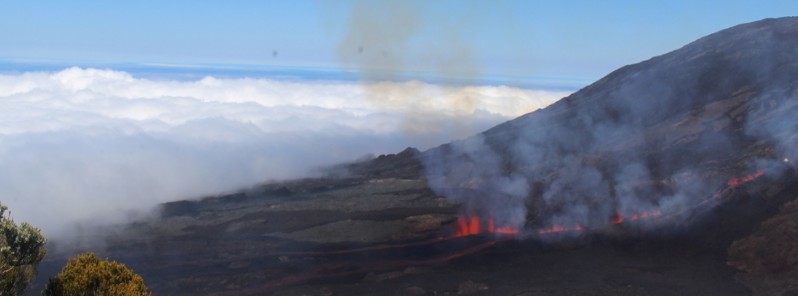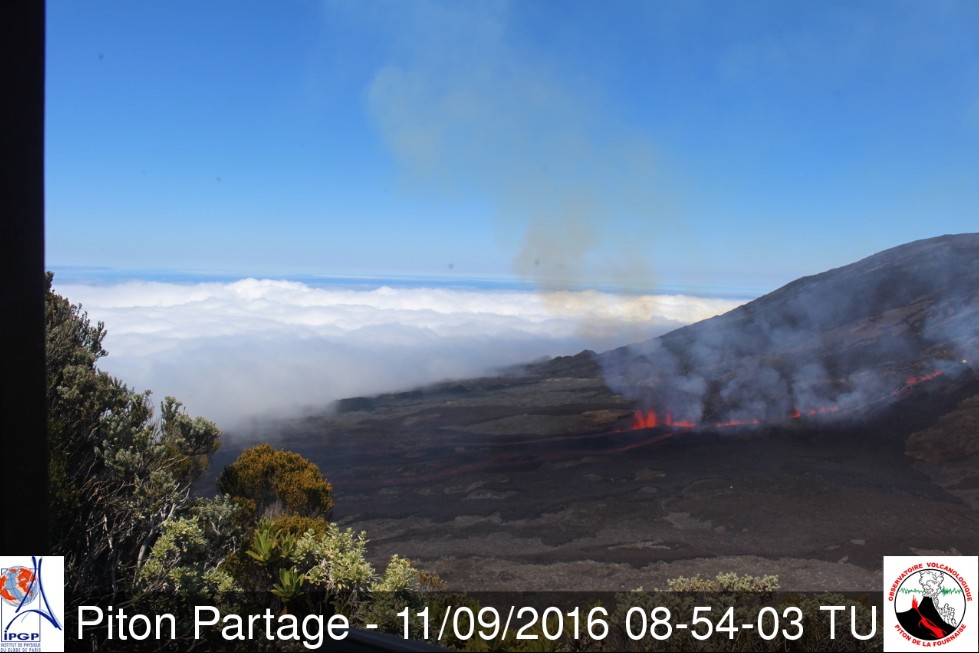New eruption starts at Piton de la Fournaise, La Réunion

A new eruption has begun at La Réunion's Piton de la Fournaise volcano at 04:41 UTC (08:41 local time) on September 11, 2016.
An eruptive fissure opened on the upper north side of Dolomieu, generating a curtain of lava fountains along the fissure feeding several lava flows directed north and northwest, the Volcano Discovery reported. There had been no particular precursory signs during the days before, according to a statement of the prefecture.
The eruption occurred after a major seismic crisis that began in the night from Saturday to Sunday. "Throughout the night, we observed an increase in seismic activity, much higher than that observed in previous days. It was shortly after 3:00 [UTC] that everything has accelerated," said Philip Kowalski, deputy director of Observatoire Volcanologique du Piton de la Fournaise (OVPDLF).
Public access to the Enclos has been closed by authorities.

Credit: iPGP / OVPDFL
This year's first eruption of Piton de la Fournaise started around 04:41 UTC on May 26. OVPDLF reported that CO2 gas emission, deformation, and seismicity at Piton de la Fournaise began to slowly increase on May 16, and then seismicity significantly increased at 07:40 UTC on May 25. Tremor began at 04:05 on May 26, characteristic of an ongoing eruption, likely from a new fissure near Château Fort crater.
Later that day scientists and reporters saw about six lava fountains (some were 40-50 m / 130 – 160 feet high) during brief aerial surveys and a cinder cone being built on a flat area at 1 850 m (6 070 feet) elevation about 1 – 1.5 km (0.6 – 0.9 miles) SE of Castle Crater. RSAM values significantly decreased at 14:00 UTC, increased slightly, and then stabilized. On May 27, tremor levels significantly dropped at 04:45 and then ceased at 07:00 UTC. Signals indicative of degassing continued.
- Early Sunday morning imagery of today's eruption can be found here.
Geological summary
The massive Piton de la Fournaise basaltic shield volcano on the French island of Réunion in the western Indian Ocean is one of the world's most active volcanoes. Much of its more than 530 000-year history overlapped with eruptions of the deeply dissected Piton des Neiges shield volcano to the NW. Three calderas formed at about 250 000, 65 000, and less than 5 000 years ago by progressive eastward slumping of the volcano. Numerous pyroclastic cones dot the floor of the calderas and their outer flanks.
Most historical eruptions have originated from the summit and flanks of Dolomieu, a 400-m-high (1 312 feet) lava shield that has grown within the youngest caldera, which is 8 km (26 247 feet) wide and breached to below sea level on the eastern side. More than 150 eruptions, most of which have produced fluid basaltic lava flows, have occurred since the 17th century. Only six eruptions, in 1708, 1774, 1776, 1800, 1977, and 1986, have originated from fissures on the outer flanks of the caldera. The Piton de la Fournaise Volcano Observatory, one of several operated by the Institut de Physique du Globe de Paris (IPGP), monitors this very active volcano. (GVP)
Featured image credit: iPGP / OVPDFL, September 11, 2016

Commenting rules and guidelines
We value the thoughts and opinions of our readers and welcome healthy discussions on our website. In order to maintain a respectful and positive community, we ask that all commenters follow these rules:
We reserve the right to remove any comments that violate these rules. By commenting on our website, you agree to abide by these guidelines. Thank you for helping to create a positive and welcoming environment for all.